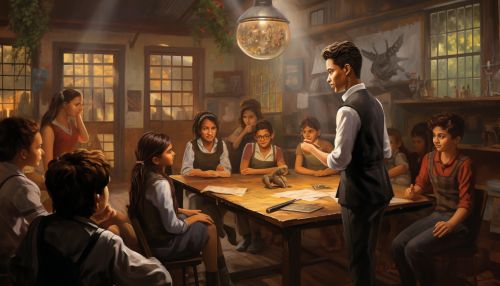Cognitive Mechanisms of Learning Through Observation
Introduction
Cognitive mechanisms of learning through observation, also known as observational learning, is a form of learning that occurs through observing the behavior of others. It is a key component of Bandura's social learning theory and has been extensively studied in the field of psychology and education. This form of learning is not just a passive process, but involves active cognitive processes such as attention, memory, and motivation.
Cognitive Processes Involved in Observational Learning
Observational learning involves several cognitive processes that work together to facilitate learning. These processes include attention, retention, motor reproduction, and motivation.
Attention
In order to learn through observation, the learner must first pay attention to the model's behavior. This involves focusing on the relevant aspects of the behavior and ignoring irrelevant details. The learner's ability to pay attention can be influenced by various factors such as the characteristics of the model (e.g., whether the model is similar to the learner or is perceived as competent), the complexity of the behavior, and the learner's cognitive abilities.
Retention
After paying attention to the model's behavior, the learner must retain the information in memory for later use. This involves encoding the observed behavior into a mental representation. The learner may also rehearse the behavior mentally or physically to strengthen the memory.
Motor Reproduction
Once the behavior has been encoded in memory, the learner must be able to reproduce the behavior. This involves translating the mental representation of the behavior into actual behavior. The learner's ability to reproduce the behavior can be influenced by their physical abilities and the availability of necessary resources.
Motivation
Even if the learner has paid attention to the model's behavior, retained the information in memory, and is capable of reproducing the behavior, they will not do so unless they are motivated. Motivation can come from various sources such as the anticipation of rewards or the avoidance of punishments. The learner's motivation can also be influenced by their beliefs about their ability to perform the behavior (self-efficacy) and the perceived consequences of the behavior.
The Role of the Observer in Observational Learning
In observational learning, the observer plays an active role in the learning process. They are not just passively absorbing information, but are actively processing and interpreting the observed behavior. This involves making inferences about the model's intentions and the consequences of the behavior, and using this information to guide their own behavior.
The Role of the Model in Observational Learning
The model also plays a crucial role in observational learning. The model's behavior provides the information that the observer uses to learn. The characteristics of the model can influence the observer's attention and motivation. For example, observers are more likely to pay attention to and learn from models who are similar to them, who are perceived as competent, and who are rewarded for their behavior.
The Role of the Environment in Observational Learning
The environment in which observational learning occurs can also influence the learning process. The availability of models, the characteristics of the environment (e.g., whether it is conducive to learning), and the consequences of the behavior in the environment can all influence the observer's attention, retention, motor reproduction, and motivation.
Applications of Observational Learning
Observational learning has been applied in various fields such as education, therapy, and training. In education, teachers can use observational learning to teach new skills and behaviors. In therapy, therapists can use observational learning to help clients change maladaptive behaviors. In training, trainers can use observational learning to train employees in new tasks.


